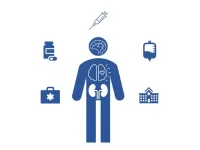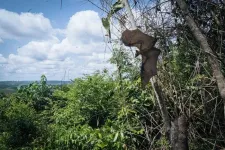Two brain mechanisms for picking speech out of a crowd
Speech is processed differently depending on whether or not it stands out – implications for hearing aids
2023-06-06
(Press-News.org) Researchers led by Dr. Nima Mesgarani at Columbia University, US, report that the brain treats speech in a crowded room differently depending on how easy it is to hear, and whether we are focusing on it. Publishing June 6th in the open access journal PLOS Biology, the study uses a combination of neural recordings and computer modeling to show that when we follow speech that is being drowned out by louder voices, phonetic information is encoded differently than in the opposite situation. The findings could help improve hearing aids that work by isolating attended speech.
Focusing on speech in a crowded room can be difficult, especially when other voices are louder. However, amplifying all sounds equally does little to improve the ability to isolate these hard-to-hear voices, and hearing aids that try to only amplify attended speech are still too inaccurate for practical use.
In order to gain a better understanding of how speech is processed in these situations, the researchers at Columbia University recorded neural activity from electrodes implanted in the brains of people with epilepsy as they underwent brain surgery. The patients were asked to attend to a single voice, which was sometimes louder than another voice (“glimpsed”) and sometimes quieter (“masked”).
The researchers used the neural recordings to generate predictive models of brain activity. The models showed that phonetic information of “glimpsed” speech was encoded in both primary and secondary auditory cortex of the brain, and that encoding of the attended speech was enhanced in the secondary cortex. In contrast, phonetic information of “masked” speech was only encoded if it was the attended voice. Lastly, speech encoding occurred later for “masked” speech than for “glimpsed’ speech. Because “glimpsed” and “masked” phonetic information appear to be encoded separately, focusing on deciphering only the “masked” portion of attended speech could lead to improved auditory attention-decoding systems for brain-controlled hearing aids.
Vinay Raghavan, the lead author of the study, says, “When listening to someone in a noisy place, your brain recovers what you missed when the background noise is too loud. Your brain can also catch bits of speech you aren’t focused on, but only when the person you’re listening to is quiet in comparison.”
#####
In your coverage, please use this URL to provide access to the freely available paper in PLOS Biology: http://journals.plos.org/plosbiology/article?id=10.1371/journal.pbio.3002128
Citation: Raghavan VS, O’Sullivan J, Bickel S, Mehta AD, Mesgarani N (2023) Distinct neural encoding of glimpsed and masked speech in multitalker situations. PLoS Biol 21(6): e3002128. https://doi.org/10.1371/journal.pbio.3002128
Author Countries: United States
Funding: This work was supported by the National Institutes of Health (NIH), National Institute on Deafness and Other Communication Disorders (NIDCD) (DC014279 to NM). The funders had no role in the study design, data collection and analysis, decision to publish, or preparation of the manuscript.
END
[Attachments] See images for this press release:

ELSE PRESS RELEASES FROM THIS DATE:
2023-06-06
Treatment efficacy for a broad range of chronic diseases does not differ depending on patients’ comorbidities, according to a new study publishing June 6th in the open access journal PLOS Medicine by David McAllister of the University of Glasgow, UK, and colleagues.
There is often uncertainty about how treatments for single conditions should be applied to people who have multiple chronic conditions (multimorbidity). This confusion stems, in part, from the fact that people with multimorbidity are under-represented in randomized controlled trials, and trials rarely report whether the efficacy of treatment ...
2023-06-06
Researchers have long thought that once a cell starts down its path of differentiation, growing into a skin cell or a liver cell or a neuron, that path could not be changed.
But over the past two decades, scientists have realized this pathway is more complex. Now, using zebrafish as a model, a University of Michigan research team has discovered that a loop in the body's mitochondria—organelles within cells that produce energy for the body—may allow cells to retreat up the path of differentiation. Their results are published in the Proceedings of the National Academy of Sciences.
"Cell fate and differentiation ...
2023-06-06
LOGAN, UTAH, USA -- South America’s Andes Mountains, the world’s longest mountain range and home to some of the planet’s highest peaks, feature thousands of hot springs. Driven by plate tectonics and fueled by hot rock and fluids, these thermal discharges vary widely in geochemistry and microbial diversity.
Utah State University geoscientists, along with colleagues from Montana State University, examined 14 hot springs within the southern Andes in Peru and discovered microbial community composition is distinctly different in two tectonic settings. Dennis Newell, associate professor in USU’s Department of Geosciences, and recent USU graduate Heather Upin, ...
2023-06-06
A new paper in the journal The Lancet Planetary Health makes the case that pandemic prevention requires a global taboo whereby humanity agrees to leave bats alone—to let them have the habitats they need, undisturbed.
Like the SARS coronavirus outbreak of 2003, the COVID-19 pandemic can be traced back to a bat virus. Whether someone handled or ate an infected bat or was exposed to a bat’s bodily fluids in a cave or some other way, or was exposed to another animal that had been infected by a bat, we will quite likely never know. Even a virus released via a lab accident would still have originally come from ...
2023-06-06
The Laurie and Todd Platt BrainHealth Project MRI Scanner will help researchers identify neural markers of improved brain health
Center for BrainHealth® celebrates major contributions reaching more than $1 million to support discoveries of brain improvement biomarkers. This investment in advancing the science of brain health is made possible by Sarah and Ross Perot, Jr., Laurie and Todd Platt and many of their friends.
The Sammons BrainHealth Imaging Center is dedicated to discovering a scalable panel of brain measurements correlating physical changes in the brain with changes in a holistic composite metric of brain ...
2023-06-06
A successful long-term experiment with live hogs indicates Nebraska scientists may be another step closer to achieving a safe, long-lasting and potentially universal vaccine against swine flu.
The results are not only important to the pork industry, they hold significant implications for human health. That’s because pigs act as “mixing vessels,” where various swine and bird influenza strains can reconfigure and become transmissible to humans. In fact, the 2009 swine flu pandemic, involving ...
2023-06-06
LOGAN, UTAH, USA -- The 1,200-mile-long Denali Fault stretches in an upward arc from southwestern Alaska and the Bering Sea eastward to western Canada’s Yukon Territory and British Columbia. The long-lived and active strike-slip fault system, which slices through Denali National Park and Preserve, is responsible for the formation of the Alaska Range.
“It’s a big, sweeping fault and the source of a magnitude 7.9 earthquake in 2002, that ruptured more than 200 miles of the Denali Fault, along with the Totschunda Fault to the east, causing significant damage to remote villages and central Alaska’s infrastructure,” says Utah State University ...
2023-06-06
Many neurological conditions that involve involuntary muscle contractions have long been considered as diseases of the brain. However, both the brain and the spinal cord contain many nerve cells associated with movement.
The research, published in Science Translational Medicine, used state-of-the-art mouse genetics to distinguish whether the brain or spinal cord was responsible for the disorganisation of movement experienced by dystonia patients.
Focusing on the most common inherited form of dystonia called DYT1, UCL scientists confined a genetic mutation to the spinal cord of the ...
2023-06-06
Flat-faced dogs, such as French and English Bulldogs, are extremely popular despite suffering from severe innate diseases. Hungarian researchers have attempted to uncover the explanation for this paradox. In the end, they concluded that although enthusiasts of flat-faced dogs are aware of the health issues and strive to provide the best for their dogs, they are likely to normalize health problems.
The French and English Bulldogs are among the most popular breeds in both the United States and Europe, but Pugs ...
2023-06-06
Irvine, Calif., June 6, 2023 — The quality of care for nursing home residents with Alzheimer’s disease and related dementias is best when they are in the majority, but most facilities also accommodate a heterogeneous population, where specialized staff training is limited, according to a study led by the University of California, Irvine.
“Recognizing and managing the complex medical conditions and behavioral symptoms of residents with ADRD require enhanced knowledge among staff. These findings raise significant concerns regarding the level of care and quality of life for the majority of these people, highlighting ...
LAST 30 PRESS RELEASES:
[Press-News.org] Two brain mechanisms for picking speech out of a crowd
Speech is processed differently depending on whether or not it stands out – implications for hearing aids







